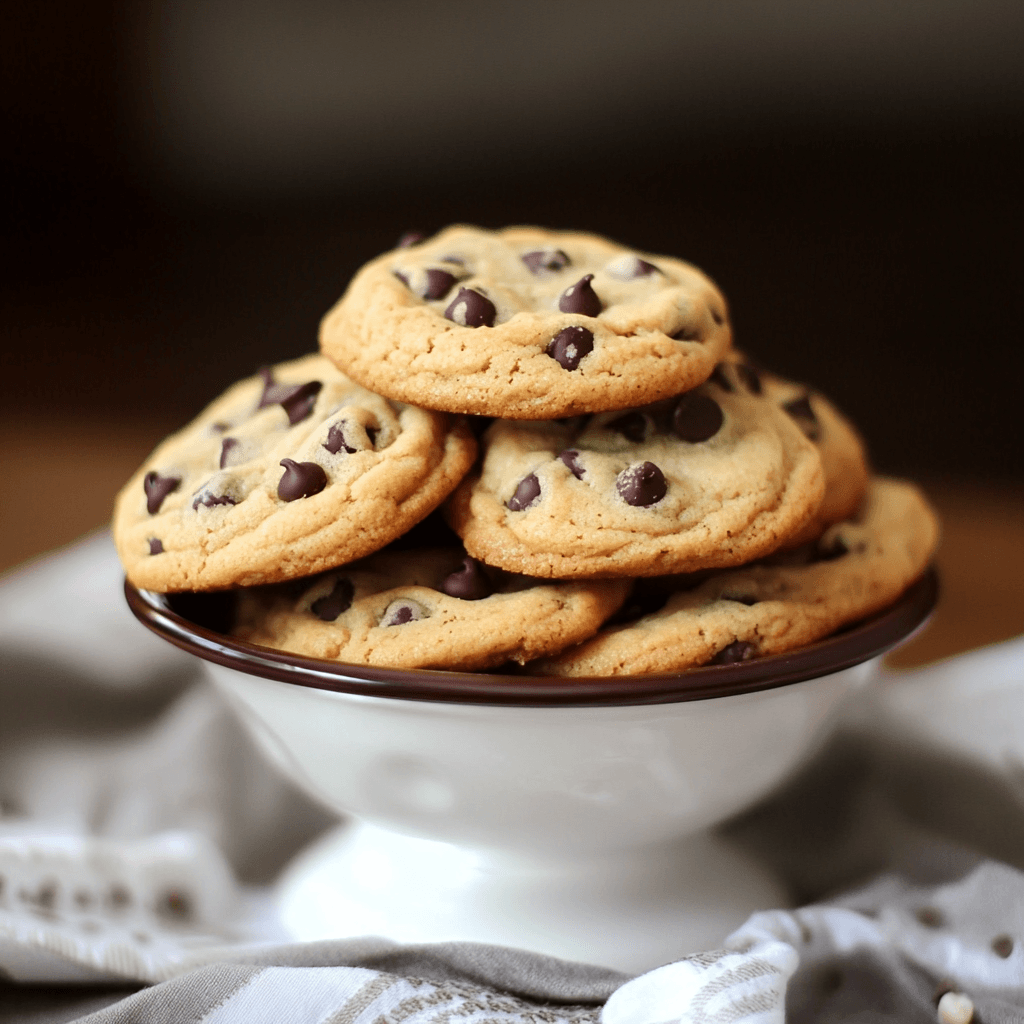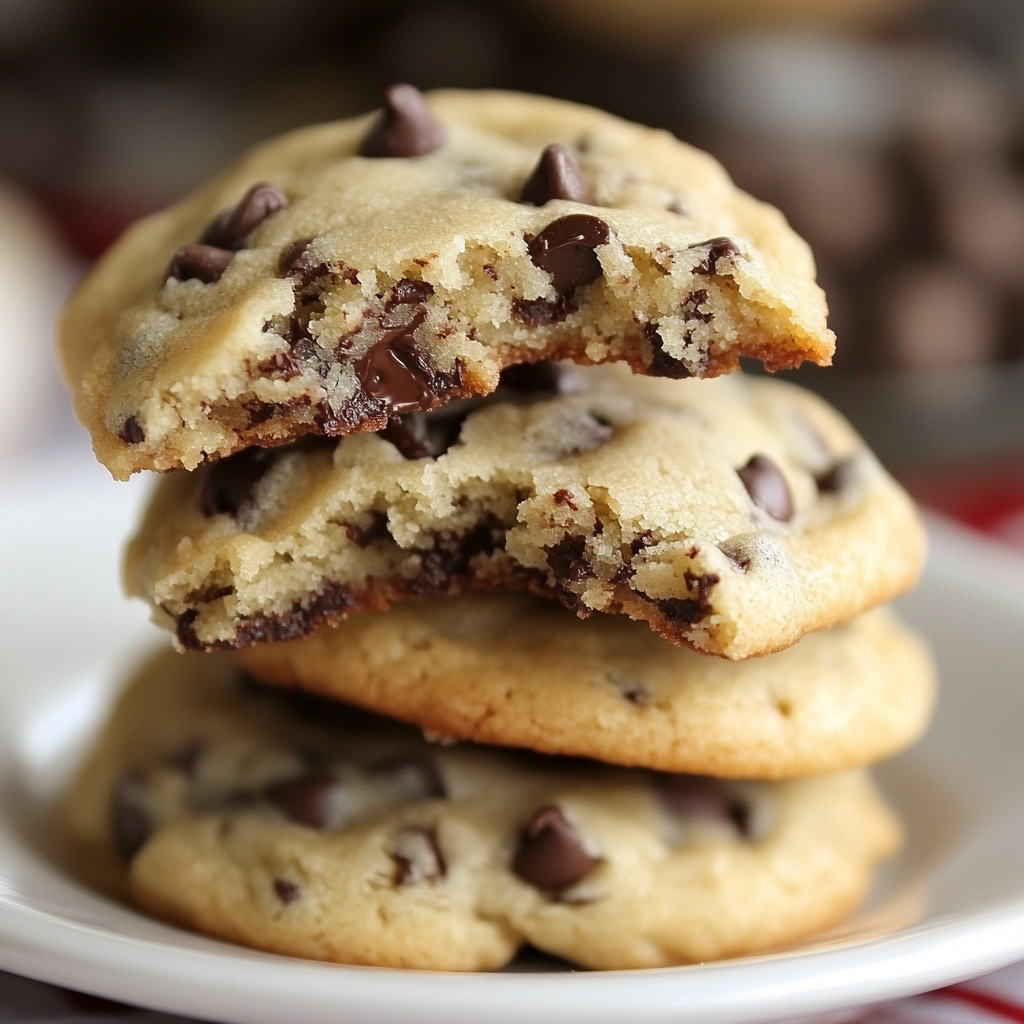Introduction
What Makes Chocolate Chip Cookies Soft?
The key to soft chocolate chip cookies lies in the ingredients and the method used to bake them. For example, using butter, brown sugar, and eggs adds moisture, which helps create a tender texture. Additionally, baking the cookies just until the edges are set ensures they stay soft in the middle. These steps make soft chocolate chip cookies a favorite for many people who enjoy a chewy and rich dessert.
History of Chocolate Chip Cookies
Chocolate chip cookies were invented in 1938 by Ruth Wakefield, who owned the Toll House Inn in Massachusetts. She wanted to make chocolate cookies but realized the chocolate pieces did not melt completely. Instead, they stayed intact, creating the world’s first chocolate chip cookies. Since then, this simple yet delicious treat has become one of the most popular desserts around the world.
Why Soft Cookies Are the Favorite Choice
Soft chocolate chip cookies are loved for their melt-in-your-mouth texture. Unlike crunchy cookies, which can feel dry, soft cookies are chewy and satisfying. Furthermore, they appeal to both kids and adults, making them a versatile option for any occasion. Whether you’re baking for a party or just want a cozy snack, soft cookies are a great choice.
Essential Ingredients for Soft Chocolate Chip Cookies
Key Ingredients Breakdown
To make the perfect soft chocolate chip cookies, it’s important to know how each ingredient works:
- Butter: Adds moisture and flavor, which helps create a soft texture.
- Brown Sugar: Keeps the cookies moist and adds a slight caramel flavor.
- Eggs: Help bind the dough and keep the cookies tender.
- Vanilla Extract: Enhances the overall flavor, making the cookies taste rich.
- Flour: Provides structure while allowing the cookies to stay soft and chewy.
- Baking Soda: Helps the cookies rise and makes them light and airy.
- Salt: Balances the sweetness and brings out the flavors.
- Chocolate Chips: The star ingredient that gives the cookies their classic taste.
By understanding how these ingredients work together, you can ensure your cookies turn out perfectly soft every time.
Substitutions for Dietary Preferences
If you need to adjust the recipe for dietary needs, there are many substitutions you can try. For example:
- Butter Alternatives: Use plant-based butter or coconut oil for a dairy-free option.
- Egg Replacements: Swap eggs with a flaxseed egg (1 tablespoon ground flaxseed mixed with 2.5 tablespoons of water) to make vegan cookies.
- Gluten-Free Flour: Replace regular flour with a 1:1 gluten-free blend to make the cookies gluten-free.
- Sugar Substitutes: Choose coconut sugar or a low-calorie sweetener for a healthier alternative.
These options make it easy for everyone to enjoy soft chocolate chip cookies.
Choosing the Best Chocolate Chips
The type of chocolate chips you use can change the flavor and texture of your cookies. Semi-sweet chocolate chips are a popular choice because they balance sweetness and richness. However, you can also try dark chocolate chips for a more intense flavor or milk chocolate chips for extra sweetness. Additionally, mixing in white chocolate chips, peanut butter chips, or caramel bits can add variety and make your cookies even more special.
By selecting high-quality ingredients and experimenting with flavors, you can bake cookies that everyone will love.
Tools Needed for Baking Soft Chocolate Chip Cookies
Basic Baking Tools
To bake soft chocolate chip cookies, you’ll need a few essential tools. First, mixing bowls are a must, with one large bowl for combining wet ingredients and a medium one for the dry ingredients. Second, measuring cups and spoons are essential for accurate measurements, which are key to baking success. A whisk and a rubber spatula help you mix the ingredients evenly without overworking the dough. Additionally, baking sheets lined with parchment paper or silicone baking mats prevent sticking and ensure even baking. Lastly, a cookie scoop or tablespoon ensures consistent cookie sizes, which helps them bake evenly.
With these basic tools, you’re ready to create delicious, soft cookies.
Advanced Equipment for Perfect Cookies
For bakers aiming to perfect their cookies, advanced tools can make a difference. A stand mixer or hand mixer saves time and ensures your dough is mixed consistently. Silicone baking mats provide a reusable, non-stick surface for better heat distribution. A kitchen scale is useful for precise measurements, especially if you’re scaling the recipe. To ensure even baking, a cookie cooling rack is ideal for allowing air to circulate around the cookies as they cool. Finally, an oven thermometer helps you verify the exact oven temperature, as even slight temperature differences can impact your cookies’ texture.
These advanced tools can help you achieve bakery-quality results.
Step-by-Step Instructions for Making Soft Chocolate Chip Cookies
Preparing Your Workspace
Before you begin, take a few moments to prepare your baking space. Start by gathering all your ingredients and tools to avoid interruptions during baking. Preheat your oven to the recommended temperature, usually 350°F (175°C), so it’s ready when the dough is prepared. Line your baking sheets with parchment paper or silicone mats to make cleanup easier. Also, make sure your butter and eggs are at room temperature for better mixing and texture.
By setting up your workspace, you’ll ensure a smooth and stress-free baking process.
Mixing Ingredients Properly
The way you mix your ingredients significantly impacts the texture of your cookies. First, cream the butter and sugars together using a hand or stand mixer until the mixture is light and fluffy. This step incorporates air into the dough, contributing to the softness of the cookies. Next, add the eggs and vanilla extract one at a time, mixing until well combined. In a separate bowl, whisk together the dry ingredients—flour, baking soda, and salt. Gradually add the dry mixture to the wet ingredients, mixing just until combined. Finally, fold in the chocolate chips gently to avoid overmixing.
Proper mixing ensures a dough that is light, soft, and ready for baking.
Baking Tips for Softness
When it’s time to bake, follow these tips to ensure your cookies stay soft and chewy:
- Scoop Evenly: Use a cookie scoop or tablespoon to portion the dough evenly, which ensures all cookies bake at the same rate.
- Don’t Overbake: Remove the cookies from the oven when the edges are set, but the centers still look slightly underbaked. They will continue to cook as they cool on the tray.
- Cool Correctly: Let the cookies cool on the baking sheet for 2–3 minutes before transferring them to a cooling rack. This step helps them retain their shape and texture.
By following these steps, you’ll bake soft chocolate chip cookies that are perfect every time.
The Science Behind Softness
Soft chocolate chip cookies are a delight that comes down to the perfect combination of ingredients, baking techniques, and a touch of science. Let’s explore the key factors that contribute to achieving the ultimate softness in your cookies.
Role of Butter and Sugar Ratios
The ratio of butter to sugar plays a significant role in determining the texture of your cookies. Butter adds richness and creates a tender crumb, while sugar affects both taste and moisture retention:
- Butter: Using melted butter enhances softness by making the dough more pliable, ensuring that the cookies spread and remain chewy after baking.
- Sugar: Brown sugar contains more moisture than granulated sugar, thanks to its molasses content. A higher proportion of brown sugar results in softer cookies, while granulated sugar promotes crispness.
Experimenting with these ratios allows you to tweak the softness and chewiness to your liking.
Importance of Baking Time and Temperature
Baking time and temperature are crucial to achieving a soft texture:
- Lower temperatures (around 325°F/160°C) allow cookies to bake more evenly, maintaining moisture and preventing overbaking.
- Shorter baking times (typically 8–10 minutes) ensure that the cookies remain soft in the center. Removing them from the oven when they are slightly underbaked helps lock in softness as they continue to cook on the hot baking sheet.
Tricks to Lock in Moisture
Maintaining moisture is key to keeping your cookies soft:
- Chill the dough: Allowing the dough to chill for at least 30 minutes before baking gives the flour time to hydrate, enhancing softness.
- Add cornstarch: A teaspoon or two of cornstarch in the dough helps create a tender, fluffy texture.
- Seal and store properly: Once baked, store cookies in an airtight container with a slice of bread to retain moisture.
Variations of Soft Chocolate Chip Cookies
Soft chocolate chip cookies are versatile, and there are endless ways to customize them to suit dietary needs and flavor preferences.
Gluten-Free Chocolate Chip Cookies
For those avoiding gluten, creating soft and delicious cookies requires alternative flours:
- Flour substitutes: Almond flour, coconut flour, or gluten-free all-purpose blends can be used.
- Binding agents: Adding xanthan gum or guar gum helps mimic the elasticity of gluten, ensuring a chewy texture.
Vegan and Dairy-Free Versions
Vegan and dairy-free cookies can be just as soft and delightful:
- Butter substitute: Use plant-based margarine or coconut oil to replace butter.
- Egg replacement: Flaxseed meal mixed with water or applesauce can act as an egg substitute to bind the ingredients while retaining moisture.
- Milk alternatives: Almond milk, soy milk, or oat milk are great options for replacing dairy milk.
Adding Nuts and Other Flavors
Adding mix-ins and flavor variations can elevate the classic chocolate chip cookie:
- Nuts: Walnuts, pecans, or macadamia nuts add a delightful crunch that contrasts the soft texture.
- Flavor enhancers: A dash of cinnamon, a teaspoon of vanilla extract, or a sprinkle of sea salt can add depth to the cookies.
- Extra sweetness: Incorporating white chocolate chips, dried fruits, or even caramel bits provides additional bursts of flavor.
Soft chocolate chip cookies are a canvas for creativity, allowing you to experiment with ingredients and techniques to craft the perfect treat every time.

Common Mistakes and How to Avoid Them
Even seasoned bakers can encounter issues when aiming for soft chocolate chip cookies. Here are some common pitfalls and tips to avoid them.
Overmixing the Dough
Overmixing your dough can lead to tough, dense cookies due to the development of too much gluten.
- Tip: Mix just until the ingredients are combined. When adding flour, stir gently and stop as soon as the dry ingredients are incorporated.
Using the Wrong Temperature
Temperature affects every stage of the cookie-making process, from mixing to baking.
- Butter temperature: Using butter that’s too warm can make the dough overly soft, causing the cookies to spread too much.
- Oven temperature: An inaccurate oven temperature can result in overbaked or underbaked cookies. Too high and the cookies will brown too quickly; too low and they may dry out.
- Tip: Use room-temperature butter (soft but not melted) and preheat your oven with an oven thermometer to ensure accuracy.
Storing Cookies Incorrectly
Improper storage can make even the softest cookies turn stale or dry.
- Tip: Store cookies in an airtight container as soon as they have cooled completely. Adding a slice of bread to the container helps maintain moisture, keeping the cookies soft for longer.
Tips for Perfect Soft Chocolate Chip Cookies
Mastering soft cookies requires attention to detail in every step of the baking process. Here are some tips to achieve consistent, perfect results.
How to Measure Ingredients Accurately
Accurate measurements are critical for maintaining the right balance of ingredients.
- Flour: Too much flour can make cookies dry and dense. Use the spoon-and-level method—spoon the flour into the measuring cup and level it off with a knife.
- Butter and sugar: Use a kitchen scale for precise measurements, especially for butter and sugar, where even slight variations can impact texture.
Prepping Dough for Consistent Results
Preparation techniques can significantly affect cookie consistency.
- Chilling the dough: Refrigerating the dough for 30 minutes to an hour helps prevent excessive spreading during baking and enhances flavor.
- Scooping evenly: Use a cookie scoop to portion the dough evenly, ensuring consistent baking times and sizes.
Timing Is Everything
Timing plays a crucial role in both preparation and baking.
- Mixing: Avoid rushing through the mixing process. Cream butter and sugar for at least 2-3 minutes to aerate the dough properly.
- Baking: Remove cookies from the oven as soon as the edges set and the centers look slightly underbaked. They will continue cooking as they cool on the baking sheet.
By focusing on these tips and avoiding common mistakes, you’ll be able to bake soft, chewy chocolate chip cookies that are irresistible every time.
Storing and Freezing Soft Chocolate Chip Cookies
Proper storage and freezing techniques are essential for ensuring your soft chocolate chip cookies remain fresh and delicious, even days or weeks later. By following these tips, you can enjoy cookies at their best.
Keeping Cookies Fresh
To maintain the soft texture and fresh taste of your cookies, consider these strategies:
- Airtight containers: First and foremost, store cookies in an airtight container or resealable bag. This prevents them from drying out.
- Bread trick: Additionally, adding a slice of white bread to the container can work wonders. The bread releases moisture, which keeps the cookies soft without altering their flavor.
- Room temperature: Lastly, keep the container at room temperature for up to a week. However, avoid storing cookies in the refrigerator, as the cold air tends to make them hard and stale.
Freezing Dough for Future Baking
For those who enjoy freshly baked cookies on demand, freezing dough is an excellent option:
- Portioning: Begin by scooping cookie dough into individual balls and placing them on a baking sheet lined with parchment paper.
- Flash freezing: Next, freeze the dough balls for 1–2 hours until firm. Afterward, transfer them to a freezer-safe bag or container.
- Baking from frozen: When ready to bake, you can place the frozen dough balls directly into the oven. Simply add 1–2 minutes to the baking time for perfect results.
Nutritional Facts
Soft chocolate chip cookies are undeniably indulgent; however, understanding their nutritional profile and making a few adjustments can help you enjoy them guilt-free.
Calorie Count per Serving
On average, a soft chocolate chip cookie contains 150–200 calories, depending on its size and ingredients. Since butter, sugar, and chocolate chips contribute the most to the calorie count, monitoring these ingredients is crucial.
Healthier Ingredient Swaps
For those looking to make their cookies more nutritious, here are some effective substitutions:
- Butter: Instead of using all butter, replace half with unsweetened applesauce or Greek yogurt to reduce fat content.
- Sugar: Alternatively, swap some or all granulated sugar with coconut sugar or honey. This helps lower the glycemic index.
- Flour: Additionally, try using whole wheat flour or almond flour. Both increase the fiber and protein content of your cookies.
Balancing Sweetness with Health
Balancing sweetness with health-conscious choices is easier than you might think:
- Add-ins: For instance, mix in nutrient-rich ingredients like nuts, chia seeds, or flaxseeds.
- Portion control: Furthermore, making smaller cookies allows you to enjoy the treat without overindulging.
Serving Suggestions
Soft chocolate chip cookies are incredibly versatile and pair well with a variety of beverages and desserts. Here’s how you can serve them to elevate the experience.
Pairing with Beverages
The right beverage can complement the flavors of your cookies beautifully:
- Milk: Of course, milk is a classic and satisfying choice, whether dairy or plant-based.
- Coffee: Additionally, a hot cup of coffee enhances the sweetness and richness of the cookies.
- Hot chocolate: For a more decadent treat, serve cookies alongside a warm, velvety hot chocolate.
Creative Dessert Ideas Featuring Soft Cookies
Finally, soft chocolate chip cookies can shine in various desserts. Here are a few creative ideas:
- Ice cream sandwiches: Place a scoop of your favorite ice cream between two cookies for a delightful frozen treat.
- Cookie crumbles: Alternatively, crumble cookies over yogurt, pudding, or parfaits to add texture and flavor.
- Layered desserts: Lastly, use cookies as layers in trifles, combining them with whipped cream, fruit, and chocolate sauce for a show-stopping dessert.
By paying attention to proper storage, experimenting with healthier ingredients, and serving them creatively, you can enjoy soft chocolate chip cookies in countless ways while ensuring every bite is as delightful as the first.
Fun Facts About Chocolate Chip Cookies
Chocolate chip cookies have a rich history and widespread appeal. Here are some intriguing facts about this beloved treat.
Origin Story of the Recipe
The chocolate chip cookie was invented by Ruth Wakefield in 1938 at the Toll House Inn in Massachusetts. Contrary to popular belief, the creation was not an accident. Ruth intentionally added chopped pieces of Nestlé semi-sweet chocolate to her cookie dough, expecting the chocolate to melt and spread evenly. Instead, the chocolate retained its shape, giving birth to the classic chocolate chip cookie we love today.
- Nestlé later acquired the rights to Ruth’s recipe in exchange for a lifetime supply of chocolate, cementing the cookie’s place in culinary history.
Global Popularity and Fun Trivia
Chocolate chip cookies are not just an American favorite; they have become a global phenomenon:
- Popularity: They are one of the most baked and consumed cookies worldwide, often found in homes, bakeries, and cafes.
- National Cookie Day: The U.S. celebrates National Cookie Day on December 4, and chocolate chip cookies are often the star of the day.
- Largest Cookie: The largest chocolate chip cookie ever made weighed over 40,000 pounds and was baked in 2003 by the Immaculate Baking Company.
- Space Treat: Chocolate chip cookie dough was the first type of cookie dough baked in space aboard the International Space Station in 2020.
Frequently Asked Questions About Soft Chocolate Chip Cookie Recipe
Here are answers to some of the most common questions about making soft chocolate chip cookies:
The key to soft cookies lies in moisture retention. Using more brown sugar than granulated sugar adds moisture due to its molasses content. Additionally, slightly underbaking the cookies and chilling the dough before baking are crucial steps. Storing cookies properly in an airtight container with a slice of bread also helps maintain softness.
Fluffy cookies result from proper leavening and dough consistency. Using room-temperature butter and not overmixing the dough helps prevent excess spreading. Adding a bit more flour or chilling the dough can also contribute to fluffier cookies. Furthermore, using baking powder instead of baking soda may give the cookies a lift.
If your cookies have hardened, you can soften them by:
- Placing them in an airtight container with a slice of fresh bread or a damp paper towel for a few hours. The cookies will absorb the moisture.
- Microwaving them for a few seconds with a damp paper towel to regain some softness temporarily.
Soft cookies depend on a balance of ingredients. Brown sugar, which contains molasses, adds moisture, while melted butter makes the dough more pliable. Shorter baking times and slightly lower temperatures also help retain moisture in the center of the cookies, keeping them soft.
What’s the best way to store leftovers?
Keep leftovers in an airtight container in the fridge for up to 4 days. Reheat in the microwave or oven until hot and bubbly. For food safety tips, refer to USDA guidelines on leftovers .
Advanced Baking Tips for Enthusiasts
For those who want to take their cookie-baking skills to the next level, these advanced tips will help you create the perfect chocolate chip cookies every time.
Experimenting with Dough Resting Times
The resting time of cookie dough can significantly impact texture and flavor:
- Short resting time (30 minutes to 1 hour): This allows the flour to hydrate, making the dough easier to handle and resulting in slightly thicker cookies.
- Overnight resting: Resting the dough in the refrigerator for 12–24 hours deepens the flavor as the ingredients meld together. The sugars caramelize more effectively during baking, producing richer-tasting cookies with a chewier texture.
- Freezing for long-term storage: Dough can be frozen for weeks and baked directly from frozen, offering convenience without compromising quality.
Enhancing Flavors with Extracts
Beyond vanilla, you can elevate the flavor of your cookies with other extracts and additives:
- Almond extract: A small amount pairs beautifully with chocolate, adding a subtle nuttiness.
- Espresso powder: Incorporating a teaspoon of espresso powder intensifies the chocolate flavor without overpowering it.
- Citrus zest: Adding orange or lemon zest brings a refreshing twist to traditional chocolate chip cookies.
Troubleshooting Cookie Baking Problems
Even experienced bakers encounter challenges. Here’s how to troubleshoot common issues to ensure your cookies turn out perfectly.
Fixing Dough That’s Too Dry
Dry dough can lead to crumbly cookies that lack structure:
- Causes: Over-measuring flour, insufficient fat, or not enough liquid in the recipe.
- Solutions: Add a tablespoon of milk, water, or melted butter at a time to hydrate the dough. Mix gently to incorporate the moisture without overworking the dough.
What to Do If Cookies Spread Too Much
Over-spreading results in thin, flat cookies that may lack the desired texture:
- Causes: Warm butter, insufficient flour, or a hot baking sheet.
- Solutions:
- Chill the dough for at least 30 minutes before baking to firm up the fat.
- Ensure the butter is at room temperature—not melted—when preparing the dough.
- Use parchment paper or a clean baking sheet to prevent excess spreading.
Salvaging Burnt Edges
Burnt edges can ruin the look and taste of your cookies, but they’re not always a lost cause:
- Prevention: Bake cookies on the middle rack of the oven to ensure even heating. Rotate the baking sheet halfway through baking.
- Solutions: If edges are slightly burnt, carefully trim them with a sharp knife or scissors. Pair the trimmed cookies with ice cream or crumble them for use as a topping in parfaits or yogurt bowls.
Suggested Internal Linking Paragraph for “Soft Chocolate Chip Cookie Recipe”
If you’re perfecting the ultimate soft chocolate chip cookie recipe, you might also enjoy exploring related recipes to broaden your baking skills. Try the ultimate guide to Toll House chocolate chip cookie recipes for a nostalgic twist or dive into the ultimate guide to Nestle chocolate chip cookie recipes for a classic favorite. For something a bit more unique, check out the ultimate guide to monster cookie recipes to add a fun and colorful spin to your cookie creations.
Conclusion
Recap of Key Tips
Mastering the art of baking soft chocolate chip cookies boils down to a few key tips: use room-temperature ingredients, measure your flour precisely, and don’t skip the chilling time for the dough. These small but essential steps ensure your cookies have that perfect soft and chewy texture every time.
Encouragement to Experiment
Don’t be afraid to experiment with your recipe! Try adding a sprinkle of sea salt for a gourmet touch or incorporating different types of chocolate for a unique flavor profile. Baking is as much about creativity as it is about precision, so embrace the opportunity to make your cookies your own. With practice and a little curiosity, you’ll soon have a recipe that’s not only delicious but entirely your own. Happy baking!





